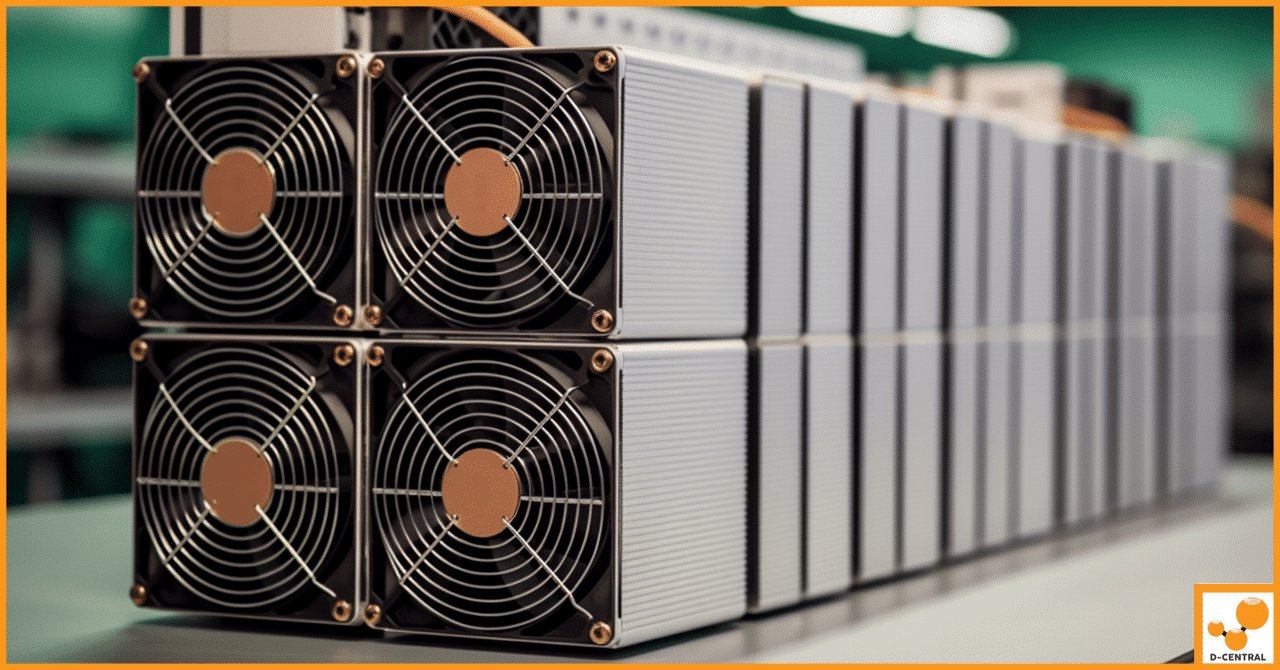
The Modern-Day Alchemists: Bitcoin Miners and AI Renderers
Bitcoin mining and AI rendering have grown in popularity over the past decade as more people realize their potential to
4479 Desserte Nord Autoroute 440, Laval, QC H7P 6E2

In the ever-evolving world of blockchain technology, cryptocurrency mining stands as a cornerstone process, vital for the maintenance and expansion of the digital currency ecosystem. Mining involves the use of sophisticated hardware to solve complex mathematical problems, thereby validating transactions and creating new blocks on the blockchain. This not only ensures the integrity and security of the decentralized network but also introduces new coins into circulation, rewarding miners for their crucial contributions.
At the heart of mining operations lies the concept of mining shares, a critical element that determines the reward distribution among miners within a pool. A share represents a miner’s proof of work—essentially a valid solution to the cryptographic puzzle required to secure the blockchain. However, not all shares contribute to the discovery of a new block; those that do are termed ‘accepted shares,’ while their counterparts, ‘rejected shares,’ fail to make the cut due to various reasons such as timing issues or data errors.
Understanding rejected shares is paramount for miners aiming to optimize their operations. Rejected shares represent potential profits lost, as they are work units that, for one reason or another, were not accepted by the mining pool. The reasons behind share rejection range from network latency to hardware inefficiencies, each impacting the miner’s bottom line. Therefore, a deep dive into the causes, impacts, and strategies for minimizing rejected shares is not just beneficial but essential for enhancing mining profitability and efficiency. By exploring these facets, miners can unlock the full potential of their mining operations, ensuring that their efforts yield the maximum possible return.
Mining shares represent units of proof-of-work in the cryptocurrency mining process, serving as evidence that a miner has contributed computational power towards solving a cryptographic puzzle. Each share is essentially a partial solution to the puzzle required to validate a new block on the blockchain. While these shares might not be complete solutions leading directly to block discovery, they are crucial in demonstrating the effort each miner has put into the mining process within a pool.
Shares play a pivotal role in the mining process, particularly within mining pools. A mining pool is a group of miners who combine their computational resources to increase their chances of solving the cryptographic puzzles and earning rewards. When a miner in the pool finds a partial solution to the puzzle, they submit this as a ‘share’ to the pool. The pool then tracks the number of shares each participant contributes, which directly influences how the rewards, earned upon successfully mining a block, are distributed among the pool members. This system ensures a fair allocation of rewards based on the amount of work each miner contributes, regardless of who actually finds the complete solution to the puzzle.
The distinction between accepted and rejected shares is critical in understanding mining efficiency and profitability. Accepted shares are those that meet the criteria set by the mining pool and are counted towards the miner’s contribution to the pool’s efforts in finding a new block. These shares are valid attempts at solving the cryptographic puzzle, even if they do not directly lead to the discovery of a new block.
On the other hand, rejected shares are those that, for various reasons, do not meet the pool’s criteria and are not counted towards the miner’s contribution. Rejected shares can result from several issues, including high network latency causing shares to be submitted too late (stale shares), incorrect solutions due to hardware errors, or shares that do not meet the pool’s difficulty requirements. Rejected shares represent wasted effort and potential loss of revenue for miners, as they do not contribute to earning rewards from the mining pool.
Understanding the balance between accepted and rejected shares is essential for miners aiming to optimize their operations. Minimizing rejected shares and maximizing accepted ones can significantly enhance a miner’s profitability and the overall efficiency of the mining process.
Rejected shares in cryptocurrency mining are work units submitted by miners to the pool that fail to be accepted due to various discrepancies or issues. These shares, despite representing a miner’s effort to solve the cryptographic puzzles necessary for block validation, do not meet the specific criteria set by the mining pool and, as a result, do not contribute towards the collective goal of finding a new block. The rejection of shares is a critical aspect of mining that directly impacts a miner’s efficiency and profitability, as it denotes effort that does not translate into rewards.
Shares are rejected for several reasons, all of which boil down to the shares not aligning with the pool’s requirements or the broader network’s rules. High network latency can lead to shares being submitted too late, rendering them outdated by the time they reach the pool. Hardware errors or misconfigurations can produce incorrect solutions or shares that do not meet the pool’s difficulty level. Additionally, software bugs or incompatibilities can lead to the generation of invalid shares. The mining pool’s role is to ensure that every share accepted and counted towards rewards is valid and timely, necessitating the rejection of shares that do not meet these criteria.
Understanding the different types of rejected shares can help miners diagnose and address the underlying issues, thereby reducing their occurrence and optimizing mining operations. The primary categories of rejected shares include:
Each type of rejected share points to specific operational inefficiencies or issues within the mining setup. By identifying the predominant type of rejected shares, miners can take targeted actions to mitigate these rejections, such as optimizing network connections, updating software, or recalibrating hardware settings. Reducing rejected shares is pivotal for enhancing the profitability and efficiency of mining operations, making it a key focus for miners aiming to succeed in the competitive cryptocurrency mining landscape.
The efficiency and profitability of cryptocurrency mining operations hinge significantly on minimizing rejected shares. Understanding the root causes of share rejection is crucial for optimizing mining performance. Here’s a detailed exploration of the primary factors leading to share rejection:
One of the most common culprits behind rejected shares is network latency—the delay before a transfer of data begins following an instruction for its transfer. High latency can cause shares to be submitted late, turning them into stale shares. Network instability, characterized by frequent disconnects or unreliable connections, further exacerbates this issue by disrupting the continuous flow of data between the miner and the mining pool. Both conditions can lead to a higher rate of share rejection, diminishing the miner’s contribution to the pool and, consequently, their potential rewards.
The hardware used in mining operations plays a pivotal role in the generation and submission of shares. Inefficiencies, such as outdated or underperforming hardware, can lead to the production of shares that do not meet the pool’s difficulty requirements. Hardware failures, on the other hand, can result in the generation of invalid shares or interrupt the mining process altogether. Regular maintenance and timely upgrades are essential to ensure hardware reliability and efficiency, thereby reducing the likelihood of share rejection.
Mining software acts as the intermediary between the miner’s hardware and the mining pool. Bugs within the software can lead to a myriad of issues, including the generation of duplicate or invalid shares. Software incompatibility, whether with the mining pool’s protocols or the miner’s hardware, can also result in shares being rejected. Ensuring that the mining software is up-to-date and compatible with both the hardware and the mining pool’s requirements is crucial for minimizing share rejection.
Overclocking, the practice of increasing the clock rate of a computer’s hardware components beyond the manufacturer’s specifications, is a common strategy employed by miners to boost their hardware’s performance. However, improper overclocking can lead to hardware instability, increased error rates, and, consequently, a higher number of rejected shares. Similarly, incorrect miner configurations, such as setting inappropriate difficulty levels or misconfiguring network settings, can also lead to share rejection. Careful tuning and monitoring of both overclocking settings and miner configurations are essential to strike a balance between enhanced performance and stability, thereby reducing rejected shares.
In summary, a multitude of factors can lead to the rejection of shares in cryptocurrency mining, each pointing to different aspects of the mining operation that may require optimization. Addressing issues related to network latency and instability, hardware inefficiencies and failures, software bugs and incompatibilities, as well as overclocking and improper configurations, can significantly reduce the occurrence of rejected shares. By doing so, miners can enhance the efficiency and profitability of their mining operations, ensuring a higher return on their investment in the competitive landscape of cryptocurrency mining.
The phenomenon of rejected shares, while seemingly a minor hiccup in the vast process of cryptocurrency mining, can have profound implications on the overall efficiency and profitability of mining operations. Understanding the multifaceted impact of rejected shares is crucial for miners aiming to optimize their contributions and rewards.
At the core of mining profitability lies the principle of maximizing valid work contributions while minimizing wasted efforts. Rejected shares represent efforts that do not contribute to the likelihood of solving a block, yet consume the same resources as accepted shares—electricity, computational power, and time. Each rejected share is essentially a missed opportunity for earning potential rewards from the mining pool. As the rate of rejected shares increases, the effective hash rate (the total computational power used to mine and process transactions) of a miner or mining operation decreases relative to the power being consumed, leading to lower returns on investment. This imbalance directly impacts profitability, especially in competitive mining environments where efficiency is key to staying ahead.
Mining pools aggregate the computational resources of individual miners to increase the collective chance of finding a block and receiving block rewards. The efficiency of a mining pool is measured not just by its total hash rate, but also by the quality of work submitted by its participants. High rates of rejected shares from pool members can diminish the pool’s effective contribution to the blockchain network, potentially reducing the frequency of rewards earned by the pool. Furthermore, pools often distribute rewards based on the proportion of valid shares submitted by each participant. Therefore, miners with higher rejection rates may receive a smaller share of the rewards, affecting their individual profitability and incentivizing the maintenance of optimal mining setups.
In the intricate world of cryptocurrency mining, understanding and managing your operation’s rejection rate is pivotal for optimizing profitability and efficiency. Here’s a comprehensive guide on calculating the rejection rate, along with recommendations for tools and software to monitor rejected shares, and insights into what constitutes a normal versus high rejection rate.
This calculation will give you the percentage of shares that were rejected out of the total shares submitted.
To effectively monitor your mining operation’s performance, including rejected shares, consider using the following tools and software:
Monitoring and managing your rejection rate is an ongoing process. Regular analysis helps ensure that your mining operation remains efficient and profitable. By understanding the nuances of rejection rates and utilizing the right tools for monitoring, miners can make informed decisions to optimize their setups, reduce rejected shares, and maximize their contributions to the mining pool.
Optimizing your cryptocurrency mining operation involves a multifaceted approach to minimize rejected shares. Implementing strategies to reduce network latency, maintain and optimize hardware, select the most compatible software and mining pools, and fine-tune configurations and overclocking settings can significantly enhance your mining efficiency and profitability. Here’s how:
Implementing these strategies requires a balance between pushing for optimal performance and maintaining the stability and reliability of your mining operation. Regular monitoring and adjustments based on performance data and rejection rates are key to finding the sweet spot that maximizes efficiency and minimizes rejected shares. By adhering to these best practices, miners can ensure their operations are as profitable and efficient as possible.
The journey through the intricacies of cryptocurrency mining, particularly the challenge of managing rejected shares, underscores a fundamental aspect of mining operations: efficiency is paramount. Understanding the causes and impacts of rejected shares is not merely an exercise in technical proficiency but a crucial strategy for enhancing profitability and sustainability in the competitive landscape of cryptocurrency mining.
The strategies discussed herein—from reducing network latency and maintaining hardware to selecting the right software and optimizing configurations—serve as a roadmap for miners aiming to minimize their rate of rejected shares. Implementing these strategies can lead to significant improvements in mining efficiency, reducing wasted efforts and maximizing the potential for earning rewards.
However, the quest for optimization does not end here. The field of cryptocurrency mining is dynamic, with new technologies, techniques, and challenges emerging regularly. Continuous improvement, therefore, becomes a key mantra for miners who wish to remain at the forefront of this evolving landscape. Staying informed about the latest developments, experimenting with new methods, and adapting to changes are all part of the ongoing process of optimization.
For those eager to dive deeper into mining optimization techniques, a wealth of resources is available online. Websites such as BitcoinTalk, Reddit’s r/EtherMining, and CryptoCompare offer forums and discussions where miners share insights, advice, and experiences. These platforms can provide valuable community support, helping you navigate the complexities of mining and optimization.
We encourage you to share your experiences and feedback on managing rejected shares. Your insights not only contribute to your own knowledge base but also help build a richer, more informed mining community. Whether you’ve successfully reduced your rejection rate or are seeking advice on specific challenges, your stories are a valuable part of the collective learning process.
In conclusion, the path to optimized mining operations is both challenging and rewarding. By embracing the strategies for minimizing rejected shares and committing to continuous improvement, miners can enhance their profitability and contribute to the robustness and security of the blockchain networks they support. Let’s continue to share, learn, and grow together in this fascinating journey through the world of cryptocurrency mining.
What are mining shares in cryptocurrency mining?
Mining shares represent units of proof-of-work in cryptocurrency mining, indicating that a miner has contributed computational power towards solving cryptographic puzzles necessary for block validation. Shares can be ‘accepted,’ contributing towards rewards, or ‘rejected,’ representing effort that does not lead to earning rewards.
What is the role of shares in the mining process?
Shares are crucial within mining pools, demonstrating each miner’s contribution to the collective effort of solving cryptographic puzzles. The number of shares submitted influences how rewards are distributed among pool members, ensuring fair allocation based on individual contributions.
Why are some shares rejected in the mining process?
Shares are rejected due to issues like high network latency, hardware inefficiencies or failures, software bugs or incompatibilities, and incorrect configurations. Rejected shares represent wasted effort and potential loss of revenue for miners, as they do not contribute to earning rewards.
What impact do rejected shares have on mining operations?
Rejected shares decrease the efficiency and profitability of mining operations, consuming resources without contributing to rewards. A high rate of rejected shares lowers the effective hash rate and can diminish the miner’s share of rewards from the pool, affecting overall mining profitability.
How can miners minimize the occurrence of rejected shares?
Miners can reduce rejected shares by optimizing network connections, maintaining and updating hardware, ensuring software compatibility, and fine-tuning miner configurations. Strategies include using wired connections, selecting closer mining pools, regular hardware maintenance, updating software, and careful overclocking.
What constitutes a normal vs. high rejection rate?
A normal rejection rate is generally below 1%, indicating most shares contribute towards rewards. A rejection rate above 1% needs attention, as it suggests inefficiencies in the mining setup that may require optimization to improve profitability and efficiency.
DISCLAIMER: D-Central Technologies and its associated content, including this blog, do not serve as financial advisors or official investment advisors. The insights and opinions shared here or by any guests featured in our content are provided purely for informational and educational purposes. Such communications should not be interpreted as financial, investment, legal, tax, or any form of specific advice. We are committed to advancing the knowledge and understanding of Bitcoin and its potential impact on society. However, we urge our community to proceed with caution and informed judgment in all related endeavors.
Related Posts

Bitcoin mining and AI rendering have grown in popularity over the past decade as more people realize their potential to

A crucial aspect of engaging with cryptocurrencies, particularly Bitcoin, is understanding the legal landscape surrounding them. In Canada, the legal

As a cryptocurrency enthusiast and miner, I am always on the lookout for ways to improve my mining performance and